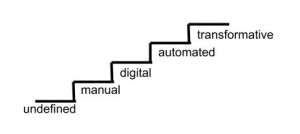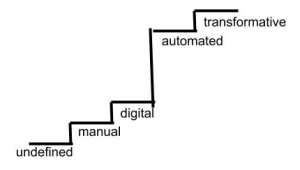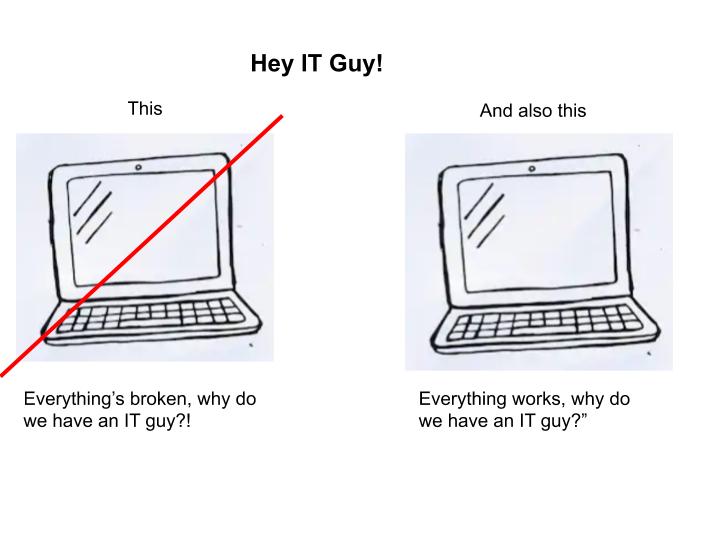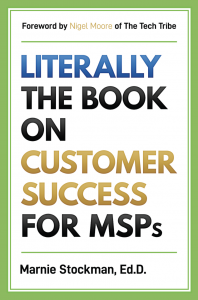
As an MSP owner who has been into technology from a young age, I have always chuckled at this evolution of mankind visual. As tools helped humanity advance, our posture became upright. Then the further evolution of technology has seemingly reverted our posture having us hunched over a keyboard.

Thinking of the maturation of the MSP industry, I visualized what the evolution of an MSP looks like. Here’s what I came up with:

Stage 1: Reactive
Company begins life as a break/fix shop. It doesn’t matter if you’re a one man show or a 10 person team – in the break/fix business, revenue is unstable because clients only call when something is broken. Hourly billing is the main (or only) revenue source, so when you and your team aren’t billing, you’re hard at work trying to find the next project for which you can charge your clients. This leads to a never-ending cycle of the MSP owner approaching clients asking them to spend more and more money on projects with varying schedules.
Stage 2: Proactive
As trust builds and clients require more security, stability, and reliability, the break/fix shop begins offering Managed Services. After researching an array of solutions for PSA, RMM, and IT Documentation tools – with the swipe of a credit card and several hours of implementation time, you now have a proactive solution to offer your clients. The business owner now spends more time in the office managing a remote team than they spend in front of clients building relationships, but revenue is stabilizing and the company experiences fewer revenue peaks and valleys. Your most mature clients will want you to meet with them regularly to provide status updates and strategic consultations.
Stage 3: Trusted Advisor/Strategic Partner
With highly mature processes in place, the MSP now is able to focus their business on improving the profitability for their business AND for their clients’ businesses. Automated tools allow them to provide business review insights to ALL clients. With a segmented approach, these MSPs have become trusted advisors. Their clients enjoy the benefits of having a strategic partner in technology planning and budget forecasting.
The question is: how does an MSP evolve as a business? Interestingly enough, the answer is the same for any business or process that aims for a transformational improvement. The MSP business must follow the steps up the Process Maturity Model.
The Process Maturity Model
The first time I heard about the process maturity model was from a technology research officer who was describing how developing mature technology solutions can help impact data availability and usage to transform a business. Then he drew a simple model:

He described the model with a basic data collection example: Think about some data we all use – phone numbers. The process of collecting phone numbers used to be an excessively undefined process – writing them down on scraps of paper or palms of hands or repeating a sing song version to help memorize them. At a broader scale it was more manual. There was a phone book where you could manually search for a number. The 411 information line digitized it so you didn’t have to be at a phone book. Finally… let me google that for you: phone number of pizza place
That jump to automated was truly transformational because you have any number you might need, from any location in the world, at your fingertips and can search for what you might be looking for instead of having to know the name of the pizza place nearest you.
After describing the reality behind the model, I revisualized the model to look like this:

Automating a process leads to and allows for transformation. That jump from digital to automated makes the impact.
And this doesn’t just work for data. I decided to look around my personal to do list and see if there were any undefined or manual processes that were in need of transformation or an efficiency overhaul. Grocery shopping bubbled to the top. Not only is that a major time sink, it is a very manual process for me and one I don’t enjoy. I considered delivery options or store pick-up, but I realized my least favorite part was putting the groceries away. That’s when it dawned on me that sometimes automating a process could simply mean transferring the task to a lower cost resource. In this case, those lower cost resources were my teenage drivers who enjoyed running errands with their newfound freedom (in a minute, we will see how that lower cost resource is an intern at our MSP). With my credit card, a shopping list – via text, of course, and permission to buy the dessert of their choosing, I completely transformed my efficiency level around grocery shopping. Now I can spend those two hours on something more impactful.
So my two key takeaways were:
- Automation (not just digitization) leads to transformation
- In some cases automation might still involve some manual work but can still make a transformational impact
As an MSP, we then ask ourselves: What do we want to transform? For our business and our clients’ businesses to grow, we aim to automate processes that save time and increase profitability. Let’s take a look at how the evolution of an MSP does just that.
From Break-fix to MSP
The Break-FIx business model is by definition an undefined process. While the business model itself is clear, when a client “breaks” a computer, the company “fixes” it for a fee. However, getting the business is very undefined. Neither the clients nor the break-fix company knows when services will be needed. And the majority of those services are manual. Manual services are very hard to scale – especially when they are inconsistent. This very concern is what typically drives a break-fix company to look at a managed services model as an MSP. Not only does the work move from reactive to proactive, the business itself follows suit. As a managed service provider, no longer is the business growing in an undefined manner. There is a recurring charge (typically monthly) that levels the income for a business and the MSP starts monitoring technical issues and deploying automation to be proactive in helping their customers.
The managed services that an MSP could provide might focus in one area or cover a larger spectrum. Many start with a narrow scope and grow their services as the needs and business grows with their clients. Services could include:
- Remote monitoring and help desk support
- Cyber security services
- Email with related cloud services
- Cloud or storage services including back-up and disaster recovery services
- vCIO Services
- Asset warranty and lifecycle management consulting
The tools required to move to these services vary based on the services provided, but could include:
- Remote monitoring and help desk platform (RMM)
- Professional services automation (PSA)
- Asset lifecycle management platform
- IT Documentation
- Back-up systems
Additional reading on these services and tools:
- Datto’s ebook on Tips for those who made the leap
- SolarwindsMSP post on Break-Fix vs. Managed services
These tools help to move the MSP forward in terms of operational maturity. The processes are now digitized or automated.
From MSP to Trusted Advisor
Now that the MSP is working proactively, it is time to up the game again. The key in any business is to show value so that this never happens…

As the MSP matures, quarterly business reviews (QBRs) become key to client retention and deepening client relationships. The customer success company, Gainsight, believes that QBRs allow MSPs to “demonstrate to the client the value they have been able to achieve.” (read more from Gainsight here) Others in the channel discuss how QBRs can help the MSP become a trusted advisor.
What does that mean and why is it important? A trusted advisor in the MSP world knows more than just the technology and IT needs of its clients. The trusted advisor understands the business goals for its clients and listens to the vision for them. They then can help build a strategic plan for how technology can positively impact those goals. Ultistic agrees in their article:
A trusted advisor is a lot more than a vendor to their clients, because they’re focused on improving their clients’ productivity, efficiencies, and net profits by eliminating business downtime and mitigating risk through the use of technology solutions.
And that is the purpose and value of a quality QBR.
The Process Maturity Model and QBRs
If QBRs help MSPs build that trusted relationship, the next step is to look at the process to maximize the potential of QBRs for both the MSP AND the clients.
The QBR itself
There is a great deal written about the contents of a quarterly business review. The common characteristics are:
- A review of the client’s systems alignment with technology standards of the MSP
- Summary of technology asset lifecycle/warranty and end of life status
- Supported users
- Budget forecasting – short and/or long term as they align to goals
- Strategic plans/projects
For MSPs who have just started to move to this review process, it can feel somewhat overwhelming. Keeping the maturity model in mind, an MSP can transform their process through automation.
QBR level 1: Manual/digital
After interviewing many MSPs, it is very clear that most enter the process of having quarterly business reviews at the manual/digital step. We often heard the phrase “cobbling together” of excel reports to aggregate the data needed to present in a QBR. With such a manual process, it takes the MSP owner (the most expensive resource) hours to build the report, which limits the number of clients that can receive a QBR. This is especially true as the MSP wants to align the reports with the business goals of the client. This provides maximum value for the client, deepens the relationship for the MSP, and ensures future work and references.
QBR level 2: Automated
The value is clear, the cost in terms of time is also evident. At this point, the MSP realizes that finding a way to automate the reporting is critical to scaling the QBR process across their client base and growing the profitability of their business. This is a where a reporting platform can help. Having a platform that aggregates data from the existing MSP tools as well as integrations with warranty look-up tools allows for the MSP to gather the asset/user/budgeting data needed.
There are a few key characteristics in a QBR reporting tool that can maximize the impact. First, the data should be always available. At a click of a button, the MSP should be able to see the warranty and end of life status for all devices AND be able to quickly filter the report to the exact data needed and export in an exec friendly report. The MSP should be able to set their policies for the status of their devices AND adjust budget forecasting windows. It should also have color-coded reporting and swatching that allows them to quickly find filtered information as needed. (Click here for an example of data swatching.)
Most importantly the tool should help the MSP quickly identify the quality of the data in the platform. (For more on data quality, click here.) Being able to provide a Tier 1 tech a printed report on any missing data allows the MSP owner to delegate any manual data updating needs to a less expensive resource (like outsourcing my grocery shopping to my teenagers).
With these elements in place, the 2-6 hours of manual aggregating asset, user, and budget information, has been reduced to a few clicks and the MSP can now focus the preparation AND the review on aligning the business goals with the technology needs.
QBR level 3: Transformation by Segmentation
Up to this point the MSP has focused their QBRs on their largest or most strategic clients. The MSP business is ready to scale and their QBR process needs to scale with it. There are many opportunities for MSPs in the SMB space (Click here for Datto’s article on the opportunity). In order to maximize the potential for those opportunities, the MSP realizes that the QBR information provided to their enterprise clients could be impactful for all.
This is where segmentation comes into play. Segmentation allows for scaling of the QBR process without the ability to clone the MSP owner. The key is to define three categories of clients: Top Tier, Mid Tier, and digital tier (Click here to read more). Using a QBR reporting platform will allow for each tier to receive their report either in person (quarterly or annually) or electronically. The MSP has now automated what has previously been an extremely manual and expensive process. By doing this, the MSP has added to the value they bring to their clients as a trusted advisor and strategic partner.

A Transformed MSP Practice
Each MSP practice is different, but the process of transforming the business parallels the process maturity model. By looking at undefined or manual processes in the work and finding practices or platforms that allow them to automate, the MSP becomes more efficient and more profitable. They are able to provide more value to their clients on their way to becoming a trusted advisor. Scaling their QBR processes through segmentation maximizes that transformation and the business for themselves and their clients.
References:
“The Essential Guide to Quarterly Business Reviews: Customer Success Software.” Gainsight, www.gainsight.com/guide/the-essential-guide-to-quarterly-business-reviews/.
Crawford, Stuart. “How Can a Managed Service Provider Become a Trusted Advisor for Their Clients?” Ulistic, 27 Aug. 2013, www.ulistic.com/blog/msp-trusted-advisor/.
“Break-Fix vs Managed Services: Which Is Right for Your Company?” Solarwinds MSP, 30 May 2019, www.solarwindsmsp.com/blog/break-fix-vs-managed-services.

